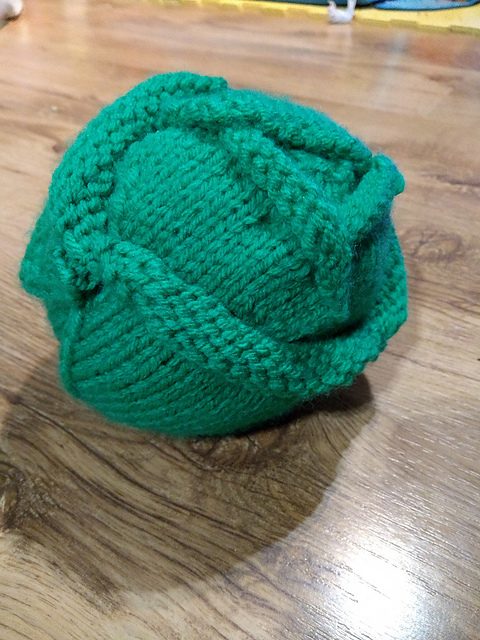Knitted Lettuce or Cabbage
Knitted lettuce or cabbage might sound peculiar at first, but it's a delightful and creative way to bring a touch of whimsy to your home décor. Imagine colorful yarn transformed into lifelike leaves and intricate stitches mimicking the texture of real veggies. These knit creations can make charming decorations for kitchen shelves, dining tables, or even as playful props for children's pretend play. Whether you opt for a lettuce head with its green frilly edges or a cabbage with its tightly knit layers, these handcrafted pieces add warmth and character to any room. So, why not spruce up your living space with a quirky touch of knitted greens that are sure to bring a smile to your face every time you see them?

Materials
-5.5mm double-pointed needles
-Stitch marker
-Two strands of DK weight yarn held together throughout
-Stuffing
-Tapestry/yarn needle for seaming
Abbreviations
St(s) = Stitch(es)
CO = Cast on
K = knit
P = purl
Inc = Increase by your preferred method
K2tog = Knit 2 stitches together
Gauge
Not important, as long as a thick fabric is achieved
Lettuce centre
The lettuce is composed of a ‘ball’ (it’s more egg shaped really), knitted in the round, with several leaves then knitted and tacked onto the ‘ball’ to give it that distinct lettuce shape.
CO6 sts, divide across three needles marking the start of the round with a stitch marker (6sts)
1 – (and all odd rounds) – K 1 round
2 – Inc all sts (12 sts)
4 – *Inc1, K2; repeat from * (18 sts)
6 – *Inc1, K3; repeat from * (24 sts)
8 – *Inc1, K4; repeat from * (30 sts)
10 – *Inc1, K5; repeat from * (36 sts)
12 – *Inc1, K6; repeat from * (42 sts)
14 – *Inc1, K7; repeat from * (48 sts)
16 – *Inc1, K8; repeat from * (54 sts)
18 – *Inc1, K9; repeat from * (60 sts)
20 – *Inc1, K10; repeat from * (66 sts)
Rounds 21-25
26- *K2tog, K9; repeat from * (60sts)
27 – (and all odd rounds) – K 1 round
28 – *K2tog, K8; repeat from * (54sts)
30 – *K2tog, K7; repeat from * (48sts)
32 – *K2tog, K6; repeat from * (42sts)
34 – *K2tog, K5; repeat from * (36sts)
36 – *K2tog, K4; repeat from * (30sts)
38 – *K2tog, K3; repeat from * (24sts)
40 – *K2tog, K2; repeat from * (18sts) – at this point, stuff ball
42 – *K2tog, K1; repeat from * (12sts), cut yarn and thread through remaining sts
This will give an egg like ball shape. The pointier end is the bottom of the lettuce. Keep this in mind when sewing on the leaves – the pointy end of the leaves go to the pointy end of the egg/ball!
Small Lettuce Leaves – make three
CO10 sts, each leaf is knit flat in st-st. Starting with a K row:
1 – Inc 1st and last st
2 – P
Repeat rows 1-2 twice more (16 sts)
7 – 10 – work in st-st
11 – k1, ssk, K to last 3sts, k2tog, k1
12 – P
Repeat rows 11-12 until 4 sts remain, BO.
These three leaves are sewn CO edge around the ‘top’ of the lettuce.
Large Lettuce Leaves – make three
CO14 sts, each leaf is knit flat in st-st. Starting with a K row:
1 – Inc 1st and last st
2 – P
Repeat rows 1-2 three more times (22 sts)
9 – 14 – work in st-st
15 – k1, ssk, K to last 3sts, k2tog, k1
16 – P
Repeat rows 11-12 until 4 sts remain, BO.
These are the final three leaves – the bottom edge (the point) is sewn onto the bottom edge of the lettuce body and then the CO edges of the leaves are sewn in the gaps created by the small lettuce leaves.